When it comes to content marketing, it can be tough to know which ones to use and which ones will make a statement. There are a variety of content marketing types that marketers can choose from. For example, Southwest likes to mix it up by posting gifs, blog posts, commercials, and retweets on their Twitter page. Delta has recently been on a video and gif kick, posting strictly commercials, videos, and gifs about flight.
It’s ultimately about what type of content marketing promotes your business effectively. And there are a handful of different content marketing types to choose from when you want to make a splash in your campaigns.
1. Blogs
Having a blog on your website that corresponds with your product and its market attracts potential customers looking for the answer your business solves. Blog posts improve SEO and can be a low-cost way to boost organic traffic.
When writing blog posts, be sure to keep these things in mind:
- Optimize your content for SEO
- Use a pillar or cluster model to organize your blog topics
- Keep your content focused and relevant to your product.
For example, Jeff Bullas has been named one of the top influential global marketing officers. Therefore, his website has blog posts about content marketing and global social media. For example, this post is about turning followers into customers.
2. Videos
Videos engage an audience quickly. According to HubSpot research, 54% of audiences want to see videos from brands they support, which is more than any other type of content.
Videos are also a versatile medium; you can create a variety of content in your industry that engages your market and leaves them wanting more. In this post, we walk you through how to use video marketing to your advantage.
For instance, design businesses can benefit from AR video marketing, which delivers a digital model of what you view using a smartphone. In 12 steps, including how to shoot with an iPhone, you can learn how to video market like a pro.
Microsoft uses their technology to empower everyone. Their recent commercials have shown just how inclusive their definition of "everyone" is, producing powerful messages about how technology can inspire many to achieve their goals.
3. Infographics
Infographics are so fun and can wake up a marketing strategy with eye-catching content. They’re bright, visually captivating ways to present stats or processes. Infographics are quick and low-cost music to a marketer’s ears.
Image Source: Towards Data Science
This infographic about content marketing gives 10 ways an infographic can make a difference in landing leads. For example, if it doesn't gain that much traction on Twitter or Instagram, try uploading it to Facebook.
Data can be easier to recognize and understand when presented in mediums like this. Further, infographics can make your product more reputable if there’s hard data involved.
4. Case Studies
Case studies are effective for leads who want to learn more about your business from the customers themselves. With case studies, buyers see a customer’s journey from start to finish and see similar use cases in real life.
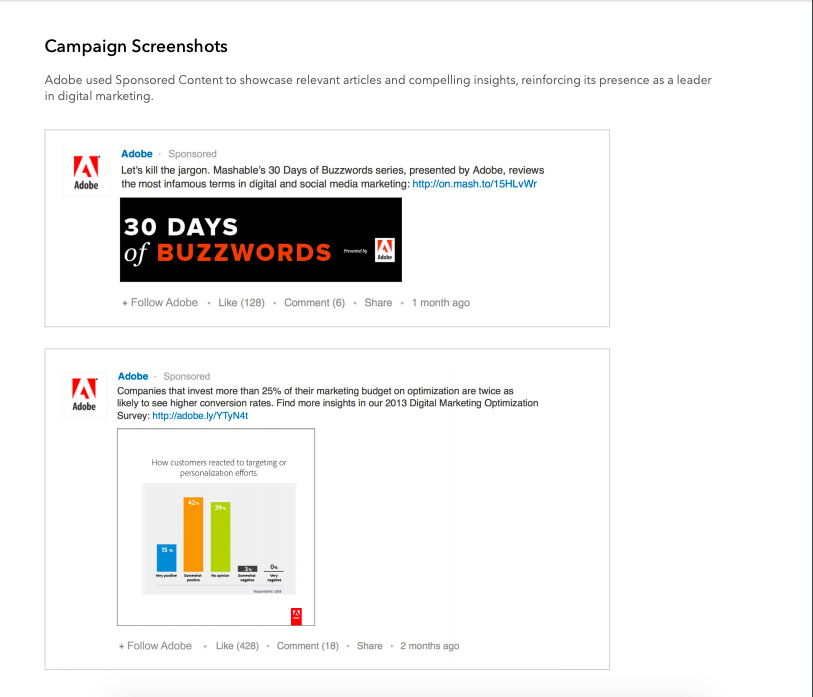
Image Source: LinkedIn
This case study by LinkedIn, provides an in-depth look at how Adobe uses LinkedIn to market their business and drive applicants. It provides data and screenshots of Adobe’s campaign and demonstrates how the brand measured their success using the workplace platform. This case study could help similar businesses see how using LinkedIn in a similar way could improve their applicants.
LinkedIn also conducts video case studies, like this one about HSBC. It shows how LinkedIn’s marketing strategy includes diversifying the way their content is presented.
5. eBooks
If you’ve never created an eBook before, think of them as long-form blog content. They’re not a novel, they’re not a multiple-page ad for your business. Instead, they’re a way to give potential clients valuable information.
The Experience Optimization Playbook by Optimizely is a free eBook that explores optimization strategies from Fortune 500 companies. For an in-depth guide on how to create eBooks, including tips on how to write effective copy (keep it short, use keywords, and check font sizes) click here.
6. User-generated content
User-generated content is an amazing content marketing method because it gets customers involved. People respond to others like them, and it’s more likely to make them interested in your business.

Image source: Netflix Is A Joke
These are user-generated content examples from Twitter. Netflix has a stand-up from Hannah Gadsby and this retweet is from a fan tweeting a quote from the special they enjoyed. A single tweet provided instantly shareable content for Netflix’s comedy account.
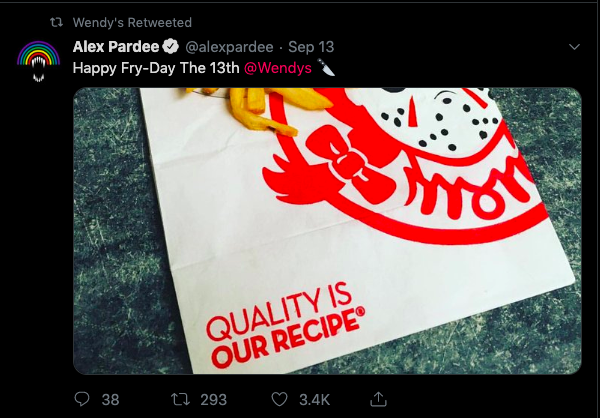
Image source: Wendy’s
This Wendy's fan tweet gave the fast-food giant a way to celebrate Friday the 13th, and promote their customers as well as their fries. As a bonus, Twitter users got to see a spooky Jason/Wendy mashup.
7. Checklists
Checklists provide value to potential customers, especially for SMB customers. They show a step-by-step method for solving a problem and can be formatted to fit your social media pages.
View this post on InstagramA new month = new goals. What's on your August to do list? 📝 #HubSpotAcademy
This example, by HubSpot Academy, shows how marketing is tied to the content with the last checkbox. It’s as easy as thinking of how your product fits into your target audience’s daily routine. You can also create an internal checklist to use for the team, making sure some content is always client-specific.
8. Memes
A form of content marketing best described as, "Don’t knock it 'til you try it." Memes are a relatively new type of content marketing, but they work extremely well. A meme is an image set with culturally relevant text that is rapidly circulated online. If you can time a meme perfectly, and align it with your social aesthetic, it’s a savvy way to increase traffic.
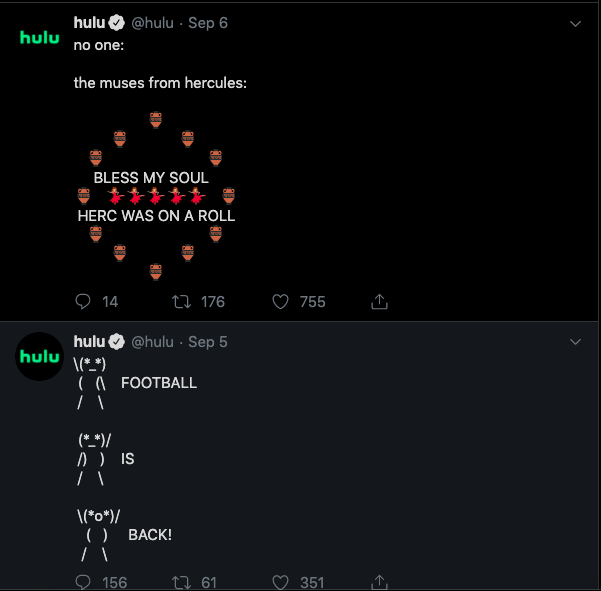
Image source: Hulu
Hulu loves using memes to promote what’s on its streaming service. That’s not surprising, considering they’re some of Hulu’s most popular tweets. Memes require digging into the current social climate and seeing where your company fits. Social listening can help with that.
9. Testimonials and customer reviews
Like user-generated content, testimonials and customer reviews are content generated straight from your audience. If you’re operating in a niche market, testimonials give a short synopsis of why your company stands out.
Nike uses testimonials from top athletes to market their shoes. In fact, most of their Instagram and commercial content comes from celebrity endorsements and reviews. Smaller businesses can benefit from adding customer reviews on their website or in emails (because we all can’t have tennis pro Simona Halep take over our social accounts).
10. Whitepapers
These often misunderstood pieces are not eBooks. Both are forms of lengthy content, but whitepapers are more densely packed with data and information. Whitepapers pay attention to detail and are a key part of the research phase for 71% of buyers, according to the Demand Gen Survey Report.
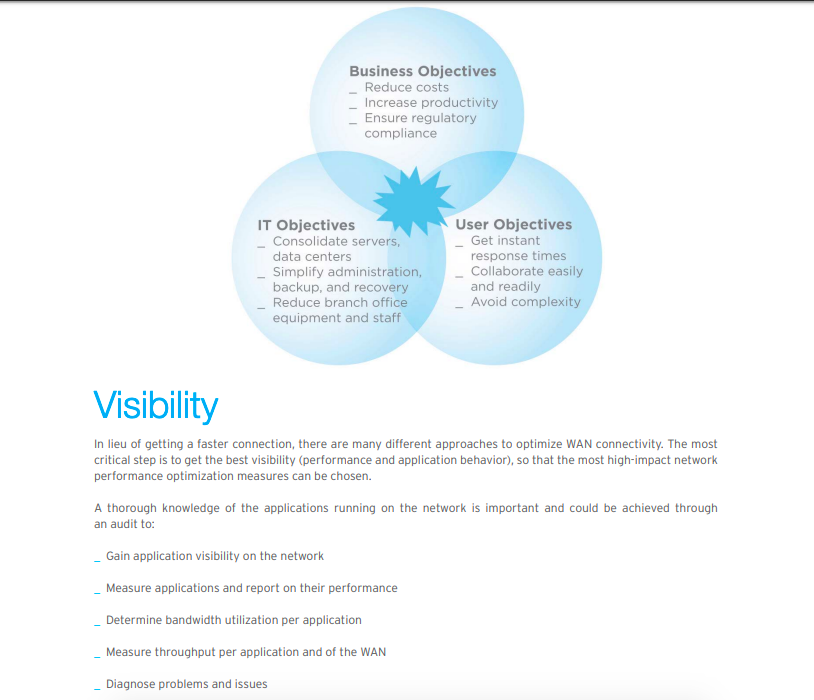
Image source: Tata Communications
This whitepaper, by Tata Communications, about network optimization is a great example of an in-depth, visually stunning document that breaks down data using charts and graphs.
Whitepapers can be visually appealing, even if the content is more … uh … utilitarian. Keep design in mind when you’re formatting page layout and key takeaways. And use appealing and easy-to-read fonts when constructing your pages, so readers are more inclined to keep turning the page.
11. How-to guides/academies
If you’re offering a product like a CRM, or any other kind of software, how-to guides are a must in content marketing. From Google Ads to Skillshare and even HubSpot, training courses are an interactive way for new and potential buyers to test drive your product before committing.
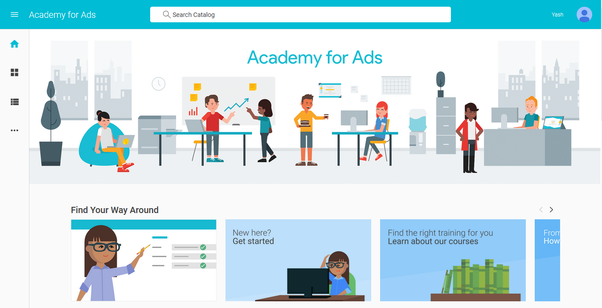
Image source: Quora
If you’re a smaller business and an academy isn’t feasible for your company, Instagram Carousels might be the answer. Carousels allow for further explanation of products/services on Instagram in a visual way. Instead of creating an entire guide, you can upload 30-second clips or multiple photos in one post and make it a highlight.
12. Influencers
Industry influencers can be highly beneficial to a marketing campaign. Having influencers promote your content can attract an entire audience you weren’t previously able to reach.
Vegan YouTuber Caitlin Shoemaker does sponsorships with other vegan brands on her socials to boost her reach and the brands’ reach as well.
To connect with an influencer in your industry, simply email their representation with a press release or reach out to their company or manager directly.
While these are our must-haves for content marketing, this definitely isn’t a definitive list of content marketing types. When it comes to content marketing, choose the types that fit your business the best and don’t be afraid to experiment. For a complete guide on content marketing, be sure to check out this post.
from Marketing https://ift.tt/2Ifw3sC
via
No comments:
Post a Comment